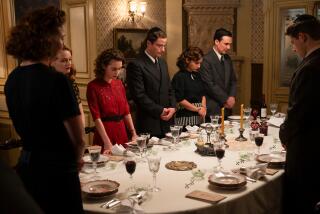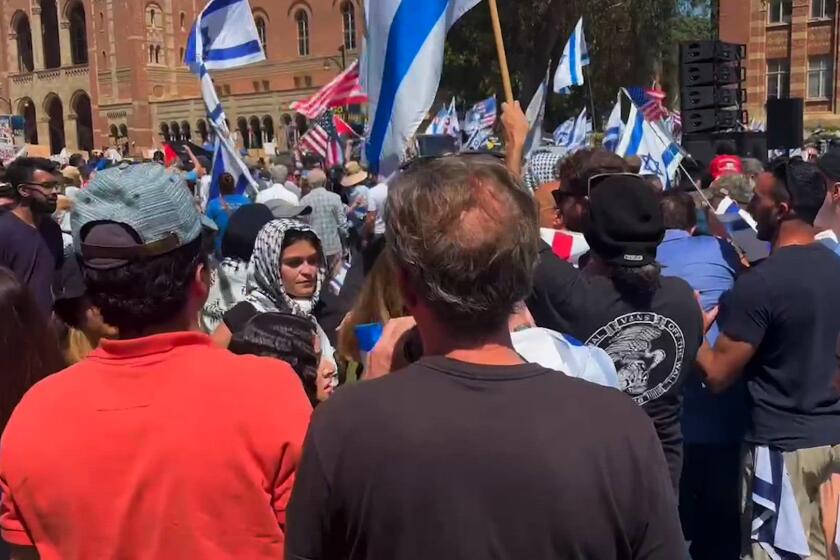An old way to understand Jewishness
In his mind’s eye, Rob Adler Peckerar is sitting with his students on a doorstep in the bustling heart of Eastern Europe. They are in a town, perhaps in Lithuania, perhaps Ukraine. It is summer, and a warm breeze rustles the trees.
The students listen, spellbound, to a story written on this very spot a century or more ago in a language that is foreign and yet strangely familiar. And before them, the pre-Holocaust world of Eastern European Jews flickers for a moment to life — rich, lusty, funny, sad and achingly poignant.
This is the idea behind the Helix project, which will begin in a very small way this summer when Adler Peckerar takes six students — three from UCLA and three from UC Berkeley — on an all-expenses-paid Jewish roots tour of Eastern Europe. Eventually, he would like to see it grow and become a viable alternative to the Birthright program that sends tens of thousands of Jewish college students annually to Israel, also free of charge.
It is, in more than one way, a deeply subversive idea.
“You know, you do a quick survey of college classes and you see that more is being taught about the destruction of Jewish culture than about the culture,” said Adler Peckerar, executive director of Yiddishkayt, an L.A.-based organization dedicated to celebrating and preserving the heritage of the Yiddish language and its culture.
“We have a whole postwar generation that has grown up knowing far more [about] Nazis and concentration camps than knowing Jewish writers and major Jewish centers of culture in Europe. And that’s terrible. To me, that is — I don’t want to be extreme about it, but it is a continuation of the Holocaust.”
Cultural identity is never simple. It is especially thorny for American Jews, whose heritage is at once cultural, national and religious, and whose “old country” no longer exists in most meaningful ways.
That leaves the definition of Jewish culture — and even the question of who is a Jew — open to debate. Which brings us back to Yiddishkayt.
Yiddish is a vernacular language that was the lingua franca of Eastern and Central European Jews for the better part of a millennium. At its peak in the years before 1939, as many as 12 million people spoke Yiddish. Today, it is in daily use by at least half a million people internationally, most of them Orthodox Jews.
Adler Peckerar’s group is part of a postmodern movement that celebrates the flowering of a largely secular Yiddish culture, one that produced an astonishing outpouring of literature, music, art and science in the late 19th and early 20th centuries before being all but silenced by the one-two punch of Soviet repression and the Holocaust.
What Yiddishkayt doesn’t tend to celebrate is the Jewish religion, and many of its leading figures are atheists. They embrace a notion of Jewishness that is purely cultural.
“There are people who aren’t interested in the synagogue route, and they don’t connect to Judaism through religion, or they don’t connect to Judaism through Israel,” said Aaron Paley, who founded Yiddishkayt in 1995 and whose family is providing the seed money for the Helix program. “This is a different way to connect with who you are.”
Adler Peckerar, a former professor of Jewish literature and culture at the University of Colorado, goes further, arguing that the Jewish religion has never been central to Jewish identity.
“I think the idea that Judaism is equal to what a Jew is — that a Jew is someone who practices Judaism — is a totally new phenomenon,” he said in an interview at Yiddishkayt’s offices in the mid-Wilshire district. A poster of the Yiddish actress Molly Picon peered over his shoulder.
Statements like that can leave some people sputtering in exasperation.
“It’s just stupid,” said Allan Nadler, director of the Jewish studies program at Drew University in New Jersey and a former director of research for YIVO, a widely respected Yiddish research institution.
Before the 19th century, Nadler said, “everything one did was governed by the religion.”
Even in the 19th and early 20th centuries, Nadler argued, most Jews remained religiously observant. “There’s something really sick about the attempt to rewrite Jewish history and establish that this secular Yiddishkayt was ever a normative form of Jewish identity,” he said.
Still, Nadler agreed that there was much worth remembering in the Yiddish culture of prewar Europe. And that is what is drawing students to the Helix program — that and the fact that they get a two-week trip to Europe on someone else’s dime.
“It just … sounded so different and so interesting that I just had to take advantage of it,” said Tessa Nath, a first-year student at UCLA who gave up plans to go to Israel so she could participate in the trip.
Tommy Kedar, a senior at Berkeley, was born in Israel and raised mostly in the United States.
“I’m 25, and the main narrative that we get about Judaism and identity and what it means to be a Jew centers around the Holocaust and Israel,” he said. Now he wants “to really understand what it was that was destroyed” in the Holocaust.
That quest drew him to the Helix program, which “builds another option and another way to understand ourselves as Jews today, even though there is a state of Israel and even though there was a Holocaust.... And it is, in a sense, an act of defiance to the destruction.”
mitchell.landsberg@latimes.com
More to Read
Start your day right
Sign up for Essential California for news, features and recommendations from the L.A. Times and beyond in your inbox six days a week.
You may occasionally receive promotional content from the Los Angeles Times.






